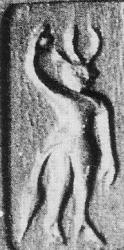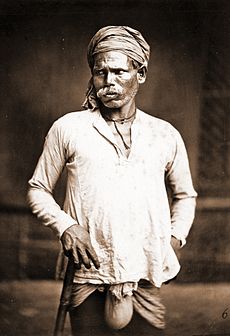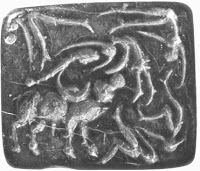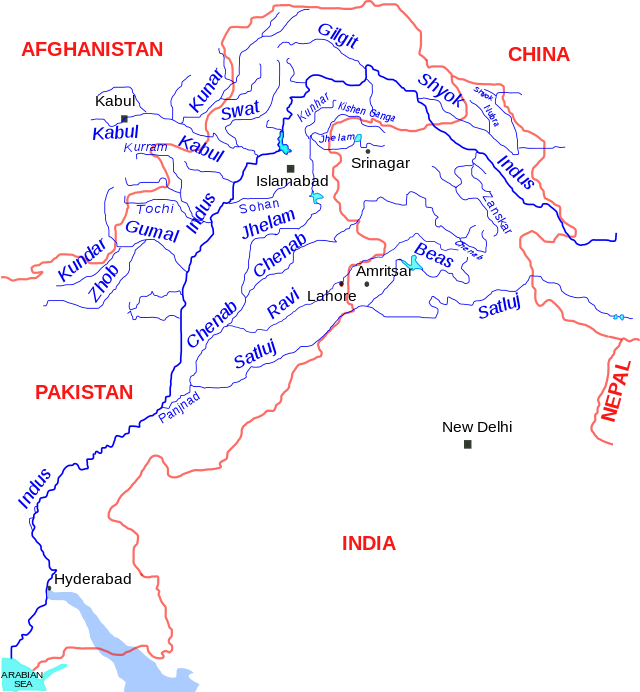This monograph provides Indus Script evidence to firmly anchor spoked wheel hieroglyph as arka cognate څرخ ṯs̱arḵẖ 'potter's wheel' (Pashto) rebus: gold, copper. ![]() Field Symbol 3 (ASI 1977, Mahadevan Concordance)
Field Symbol 3 (ASI 1977, Mahadevan Concordance)Dholavira signboard on अर्क शाल 'goldsmith workshop' and Mehrgarh spoked copper alloy wheel proclaim akṣaracaṇa 'scribe' the metallurgical competence of artisans to engrave on metal https://tinyurl.com/y6fp3zkq څرخ ṯs̱arḵẖ, s.m. (2nd) A wheel (particularly a potter's, or of a water-mill or well). 2. A grindstone. 3. Circular motion, turn, revolution, the act of turning. 4. Fortune, chance. 5. The heavens, the sphere, the celestial globe. 6. A kind of hawk or falcon, an eagle. 7. A stab, a puncture, a prick, a wound produced by a spear, an arrow, or the like. Pl. څرخرنه ṯs̱arḵẖ-ūnah; 8. adj. Punctured, pricked, pierced, stabbed; (Fem.) څرکه ṯs̱arkaʿh. څرخیدل ṯs̱arḵẖedal, verb intrans. To revolve, to turn round, to wheel. 2. To dance. Pres. څرخبږي ṯs̱arḵẖej̱ẕī (W.) or څرخیګي ṯs̱arḵẖegī (E.); past ؤ څرخیده wu-ṯs̱arḵẖedah or ؤ څرخیدَ wu-ṯs̱arḵẖeda; fut. ؤ به څرخیږي wu bah ṯs̱arḵẖej̱ẕī or ؤ به څرخیګي wu bah ṯs̱arḵẖegī; imp. ؤ څرخیږه wu-ṯs̱arḵẖej̱ẕah or ؤ څرخیګه wu-ṯs̱arḵẖegah; act. part. څرخیدونکيَ ṯs̱arḵẖedūnkaey or څرخیدونيَ ṯs̱arḵẖedūnaey; past part. څرخید ليَ ṯs̱arḵẖedalaey; verb. n. څرخیدنه ṯs̱arḵẖedanaʿh. څرخول ṯs̱arḵẖawul, verb trans. To turn, to make revolve, to wheel round. 2. To sharpen. Pres. څرخوي ṯs̱arḵẖawī; past ؤ څرخاوه wu-ṯs̱arḵẖāwuh or ؤ څرخاوو wu-ṯs̱arḵẖāwo; fut. ؤ به څرخوي wu bah ṯs̱arḵẖawī; imp. ؤ څرخوه wu-ṯs̱arḵẖawah; act. part. څرخوونکيَ ṯs̱arḵẖawūnkaey or څرخوونيَ ṯs̱arḵẖawūnaey; past part. څرخوليَ ṯs̱arḵẖawulaey; verb. n. څرخونه ṯs̱arḵẖawunaʿh. (P چرخ). څرخ کول ṯs̱arḵẖ kawul, verb trans. To pierce, to stab, to puncture. څرخ کیدل ṯs̱arḵẖ kedal, verb intrans. To enter (as a pointed instrument), to penetrate, to stab, to pierce. څرخه ṯs̱arḵẖaʿh, s.f. (3rd) A spinning-wheel, a large reel. Pl. يْ ey. (P چرخه).
It is significant that this hieroglyp of spoked-wheel appears four times on Dholavira Signboard which is a proclamation of goldsmith, metalsmith worskhop. Duplication of spoked-wheel on Dholavira Sign proclamation is dula 'pair' rebus: dul 'metal casting'; thus, gold, copper metalcasting..For a full rebus reading, see:
Potter's spoked wheel ligatured to the throat of 'unicorn' or 'spiny-horned young bull' on a Mohenjo-daro seal (FS 3,Mahadevan concordance). The rebus reading of the text message including the spoked wheel hieroglyph is:kanac 'corner' rebus:kancu 'bell-metal' PLUS agasala 'goldsmith workshop' (sal 'splinter' rebus: sal 'workshop') PLUS kolom 'three' rebus: kolimi 'smithy, forge' PLUS kolmo 'rice plant' rebus: kole.l 'smithy, forge, temple'.
arká1 m. ʻ flash, ray, sun ʼ RV. [√arc]Pa. Pk. akka -- m. ʻ sun ʼ, Mth. āk; Si. aka ʻ lightning ʼ, inscr. vid -- äki ʻ lightning flash ʼ.(CDIAL 624)*arkavarta ʻ a sort of ornament ʼ. [Cf. arkapuṭikā -- f. ʻ a silver ornament consisting of a round disk like the sun ʼ lex.: arká -- 1, *varta -- 3]
G. akɔṭī f. ʻ earring ʼ.(CDIAL 628)
Throat: Dm. argali ʻ throat ʼ, Gaw. hargal; Paš. orgól ʻ jaw (CDIAL 629).
The spoked wheel -- arka --څرخ ṯs̱arḵẖ 'potter'swheel' -- is shown on the throat of the 'spiny-horned young bull' as a semantic determinative, because the throat is signified by a similar sounding word: Dm. argali ʻ throat ʼ, Gaw. hargal; Paš. orgól ʻ jaw'. This seal thus reinforces the rebus reading of the spoked wheel as څرخه ṯs̱arḵẖaʿh 'potter's wheel', arka 'sun' rebus: arka 'gold, copper'.
It is possible that the potter's spoked wheel pre-dates the spoked wheel of a cart or chariot. The presence of cire perdue copper alloy spoked wheel shapes of a very early date ca. 4h or 5th m. BCE (called amulets by British Museum and Indus Script hypertexts by me) is also an indicator that the shape was adopted as a hieroglyph/hypertext on Indus Script inscriptions. I am speculating on the chronology of the evolution of early writing systems. See also the spoked wheels on artifact from Bhirrana which dates from 7th m BCE.
One-horned young bull hypertext/hyperimage signifies a goldsmith, lapidary: कोंद kōnda ‘young bull' कोंद kōnda ‘engraver, turner'. कुलालादिकन्दुः f. a kiln; a potter's kiln; kō̃da कोँद 'potter's kiln' (Kashmiri) Thus, an iron turner (in smithy/forge).Ta. kuntaṉam interspace for setting gems in a jewel; fine gold (< Te.). Ka. kundaṇa setting a precious stone in fine gold; fine gold; kundana fine gold. Tu. kundaṇa pure gold. Te. kundanamu fine gold used in very thin foils in setting precious stones; setting precious stones with fine gold. (DEDR 1725)
![Go to "Symbolography in Indus Seals" page Go to "Symbolography in Indus Seals" page]()
A seal explained by Rekha Rao:
The sign, if identified as falcon, may signify thunderbolt-maker: آهن ګر āhan gar, s.m. (5th) A smith, a blacksmith, thunderbolt-maker.(Assuming a variant sēṇa 'falcon' as a signifier of aśáni 'thunderbolt' Cognate ahan 'iron' (Pashto)
Thus,the textmessageon the sealmay be read rebus:
Hieroglyph 1: arka 'gold, copper' PLUS
Hieroglyph 2: kaṇḍa arka (ara) eraka kancu mũh khāṇḍā 'fire-altar (for) gold, copper, brass, moltencast copper, bell-metal ingot, implements.' PLUS
Hieroglyph 3:dhalako khanda 'ingots and equipment' PLUS
Hieroglyph4: ayo kammaTa 'alloy metal mint' OR, آهن ګر āhan gar, s.m. (5th) A smith, a blacksmith.or Thunderbolt-maker smith. PLUS Field-symbol hypertext:khonda singi 'spiny-horned young bull' rebus; konda 'fire-altar' PLUS singi 'ornament gold' PLUS kunda 'lather' rebus: kundan 'fine gold' PLUS kammaTa 'portable furnace' rebus: kammTa 'mint' PLUS sangada 'joined parts' rebus:jangadiyo 'guard accompanying treasure'.PLUS
Hieroglyphs: Dotted circles: dha 'strand' PLUS vaTTa 'circle' rebus: धावड dhāvaḍa m A class or an individual of it. They are smelters of iron. In these parts they are Muhammadans.धावडी dhāvaḍī a Relating to the class धावड. Hence 2 Composed of or relating to iron.
aśáni f. ʻ thunderbolt ʼ RV., ˚nī -- f. ŚBr. [Cf. áśan -- m. ʻ sling -- stone ʼ RV.]
Pa. asanī -- f. ʻ thunderbolt, lightning ʼ, asana -- n. ʻ stone ʼ; Pk. asaṇi -- m.f. ʻ thunderbolt ʼ; Ash. ašĩˊ ʻ hail ʼ, Wg. ašē˜ˊ, Pr. īšĩ, Bashg. "azhir", Dm. ašin, Paš. ášen, Shum. äˊšin, Gaw. išín, Bshk. ašun, Savi išin, Phal. ã̄šun, L. (Jukes) ahin, awāṇ. &circmacrepsilon; (both with n, not ṇ), P. āhiṇ, f., āhaṇ, aihaṇ m.f., WPah. bhad. ã̄ṇ, bhal. ´tildemacrepsilon; f., N. asino, pl. ˚nā; Si. sena, heṇa ʻ thunderbolt ʼ Geiger GS 34, but the expected form would be *ā̤n; -- Sh. aĩyĕˊr f. ʻ hail ʼ (X ?). -- For ʻ stone ʼ > ʻ hailstone ʼ cf. upala -- and A. xil s.v. śilāˊ -- .(CDIAL 910)
If the first sign on the left is a s'yenacit, the reading is: śyēná m. ʻ hawk, falcon, eagle ʼ RV.Pa. sēna -- , ˚aka -- m. ʻ hawk ʼ, Pk. sēṇa -- m.; WPah.bhad. śeṇ ʻ kite ʼ; A. xen ʻ falcon, hawk ʼ, Or. seṇā, H. sen, sẽ m., M. śen m., śenī f. (< MIA. *senna -- ); Si. sen ʻ falcon, eagle, kite ʼ.(CDIAL 12674) rebus: ahan 'iron' aśani 'thunderbolt; آهن ګر āhan gar, s.m. (5th) A smith, a blacksmith. P آهن āhan, s.m. (9th) Iron. Sing. and Pl. آهن ګر āhan gar, s.m. (5th) A smith, a blacksmith. Pl. آهن ګران āhan-garān. آهن ربا āhan-rubā, s.f. (6th) The magnet or loadstone. (E.) Sing. and Pl.); (W.) Pl. آهن رباوي āhan-rubāwī. See اوسپنه. څرخ ṯs̱arḵẖ A kind of hawk or falcon, an eagle.(Pashto) rebus: arka 'gold, copper';eraka 'metal infusion'(for casting)
dhal 'slanted' rebus: dhalako 'large metal ingot' PLUS खांडा [ khāṇḍā ] m A jag, notch, or indentation (as upon the edge of a tool or weapon). (Marathi) Rebus: khāṇḍā 'tools, pots and pans' .Thus, ingots and equipment.
Four corners: Four fire-altars:
kōṇṭu angle, corner, crook. Nk. kōnṭa corner (DEDR 2054b) G. khū̃ṭṛī ʻangleʼ Rebus: kõdā 'to turn in a lathe'(B.) कोंद kōnda 'engraver, lapidary setting or infixing gems' (Marathi) konda 'fire-altar, furnace'
kana, kanac 'corner' (Santali); kañcu 'bronze' (Telugu) kan- 'copper work' (Tamil).
![]() Sign 391 Spoked wheel څرخ ṯs̱arḵẖ 'potter'swheel' rebus: arka 'gold,copper'
Sign 391 Spoked wheel څرخ ṯs̱arḵẖ 'potter'swheel' rebus: arka 'gold,copper'
Rhombus-shape or oval-shape: The array of variants fromSign 270 to Sign 286) make this shape the most vivid signifier of ingot with various attributes of metallurgical description ligatured to the basic shape of the hieroglyph which is either a rhombus or oval or bun-shaped ingot:
![]() Sign 286
Sign 286![]() Variants of Sign 286
Variants of Sign 286
I submit that Sign 286 signifies కంసర 'smithery', working with bell-metal, bronze, gold, copper, eraka 'metal infusion' casting of metal equipment
gaNDA 'four'rebus: kaNDa 'equipment';thus, four corners. khɔ̃c f. ʻ corner rebus:kancu 'bell-metal, bronze'
Sign 286 is a composite of Sign 284 four marked corners of rhombus infixed with spoked wheel. The reaiding of hypertext of Sign 286 is a comprehensive catalogue of metalwork:
Hieroglyph: Corner:
![]() (Santali)
(Santali)G. khɔ̃c f. ʻcornerʼ;.*khōñcā ʻ curve, bend ʼ. [< *skuc -- beside √kuc?]P. khū̃j f., ˚jā m. ʻ corner ʼ, N. khõj, khõc, khū̃j ʻ glen, ravine, depression between two hills ʼ; H. khū̃c f. ʻ tendon Achilles ʼ; (CDIAL 3930)
Rebus:కంసాలి or కంసాలవాడు kamsāli. [Tel.] n. A goldsmith or silversmith. కంసము kamsamu [Skt.] n. Bell metal.కంచు. కంసర or కంసలల kamsara. [Tel.] n. Smithery; working in gold: adj. Of the goldsmith caste. కంసలది a woman of that caste. కంసలపని the business of a gold-smith.
Rebus: Bronze, bell-metal 2987 kāˊṁsya ʻ made of bell -- metal ʼ KātyŚr., n. ʻ bell -- metal ʼ Yājñ., ʻ cup of bell -- metal ʼ MBh., ˚aka -- n. ʻ bell -- metal ʼ. 2. *kāṁsiya -- . [kaṁsá -- 1]1. Pa. kaṁsa -- m. (?) ʻ bronze ʼ, Pk. kaṁsa -- , kāsa -- n. ʻ bell -- metal, drinking vessel, cymbal ʼ; L. (Jukes) kã̄jā adj. ʻ of metal ʼ, awāṇ. kāsā ʻ jar ʼ (← E with -- s -- , not ñj); N. kã̄so ʻ bronze, pewter, white metal ʼ, kas -- kuṭ ʻ metal alloy ʼ; A. kã̄h ʻ bell -- metal ʼ, B. kã̄sā, Or. kãsā, Bi. kã̄sā; Bhoj. kã̄s ʻ bell -- metal ʼ, kã̄sā ʻ base metal ʼ; H. kās, kã̄sā m. ʻ bell -- metal ʼ, G. kã̄sũ n., M. kã̄sẽ n.; Ko. kã̄śẽ n. ʻ bronze ʼ; Si. kasa ʻ bell -- metal ʼ.2. L. kã̄ihã̄ m. ʻ bell -- metal ʼ, P. kã̄ssī, kã̄sī f., H. kã̄sī f.*kāṁsyakara -- , kāṁsyakāra -- , *kāṁsyakuṇḍikā -- , kāṁsyatāla -- , *kāṁsyabhāṇḍa -- .
Addenda: kāˊṁsya -- : A. kã̄h also ʻ gong ʼ, or < kaṁsá -- . 2988 *kāṁsyakara ʻ worker in bell -- metal ʼ. [See next: kāˊṁsya -- , kará -- 1]L. awāṇ. kasērā ʻ metal worker ʼ, P. kaserā m. ʻ worker in pewter ʼ (both ← E with -- s -- ); N. kasero ʻ maker of brass pots ʼ; Bi. H. kaserā m. ʻ worker in pewter ʼ. 2989 kāṁsyakāra m. ʻ worker in bell -- metal or brass ʼ Yājñ. com., kaṁsakāra -- m. BrahmavP. [kāˊṁsya -- , kāra -- 1]N. kasār ʻ maker of brass pots ʼ; A. kãhār ʻ worker in bell -- metal ʼ; B. kã̄sāri ʻ pewterer, brazier, coppersmith ʼ, Or. kãsārī; H. kasārī m. ʻ maker of brass pots ʼ; G. kãsārɔ, kas˚ m. ʻ coppersmith ʼ; M. kã̄sār, kās˚ m. ʻ worker in white metal ʼ, kāsārḍā m. ʻ contemptuous term for the same ʼ. 2990 *kāṁsyakuṇḍikā ʻ bell -- metal pot ʼ. [kāˊṁsya -- , kuṇḍa -- 1]N. kasaũṛi ʻ cooking pot ʼ. 2991 kāṁsyatāla m. ʻ cymbal ʼ Rājat. [kāˊṁsya -- , tāla -- 1]
Pa. kaṁsatāla -- m. ʻ gong ʼ; Pk. kaṁsālā -- , ˚liyā -- f. ʻ cymbal ʼ, OB. kaśālā, Or. kãsāḷa; G. kã̄sāḷũ n. ʻ large bell -- metal cymbals ʼ with ã̄ after kã̄sũ ʻ bell -- metal ʼ; M. kã̄sāḷ f. ʻ large cymbal ʼ; -- Si. kastalaya ʻ metal gong ʼ (EGS 40) is Si. cmpd. or more prob. ← Pa. 2992 *kāṁsyabhāṇḍa ʻ bell -- metal pot ʼ. [kāˊṁsya -- , bhāṇḍa -- 1]Pa. kaṁsabhaṇḍa -- n. ʻ brass ware ʼ; M. kāsã̄ḍī, ˚sãḍī f. ʻ metal vessel of a partic. kind ʼ.(CDIAL 2987 to 2992)
kárṇikā f. ʻ round protuberance ʼ Suśr., ʻ pericarp of a lotus ʼ MBh., ʻ ear -- ring ʼ Kathās. [kárṇa -- ]Pa. kaṇṇikā -- f. ʻ ear ornament, pericarp of lotus, corner of upper story, sheaf in form of a pinnacle ʼ; Pk. kaṇṇiā -- f. ʻ corner, pericarp of lotus ʼ; Paš. kanīˊ ʻ corner ʼ; S. kanī f. ʻ border ʼ, L. P. kannī f. (→ H. kannī f.); WPah. bhal. kanni f. ʻ yarn used for the border of cloth in weaving ʼ; B. kāṇī ʻ ornamental swelling out in a vessel ʼ, Or. kānī ʻ corner of a cloth ʼ; H. kaniyã̄ f. ʻ lap ʼ; G. kānī f. ʻ border of a garment tucked up ʼ; M. kānī f. ʻ loop of a tie -- rope ʼ; Si. käni, kän ʻ sheaf in the form of a pinnacle, housetop ʼ.(CDIAL 2849) Rebus: kancu 'bronze,bellmetal'.
kaṇḍa arka (ara) eraka kancu mũh khāṇḍā 'fire-altar (for) gold, copper, brass, moltencast copper, bell-metal ingot, implements.'
![]() aya 'fish' rebus: aya 'iron' ayas 'alloy metal' PLUS 'one' ligature koḍa 'one' rebus: koḍ 'workshop' PLUS 'wings' ligature which is a hieroglyph: kambha 'wing' rebus: kammaṭa 'mint, coiner, coinage'.
aya 'fish' rebus: aya 'iron' ayas 'alloy metal' PLUS 'one' ligature koḍa 'one' rebus: koḍ 'workshop' PLUS 'wings' ligature which is a hieroglyph: kambha 'wing' rebus: kammaṭa 'mint, coiner, coinage'.  aya 'fish' rebus: aya 'iron' ayas 'alloy metal' PLUS 'one' ligature koḍa 'one' rebus: koḍ 'workshop' PLUS 'wings' ligature which is a hieroglyph: kambha 'wing' rebus: kammaṭa 'mint, coiner, coinage'.
aya 'fish' rebus: aya 'iron' ayas 'alloy metal' PLUS 'one' ligature koḍa 'one' rebus: koḍ 'workshop' PLUS 'wings' ligature which is a hieroglyph: kambha 'wing' rebus: kammaṭa 'mint, coiner, coinage'. ![]() Sign 284
Sign 284![]() Variants of Sign 284
Variants of Sign 284 ![]() Sign 285 is a composite of hieroglyphs: Sign 267
Sign 285 is a composite of hieroglyphs: Sign 267 ![]() four corners, four short linear strokes as circumscript. kaṇḍa kancu mũh khāṇḍā 'bell-metal ingot, implements (from) fire-altar'.
four corners, four short linear strokes as circumscript. kaṇḍa kancu mũh khāṇḍā 'bell-metal ingot, implements (from) fire-altar'. ![]() Sign 286
Sign 286![]() Variants of Sign 286
Variants of Sign 286 

















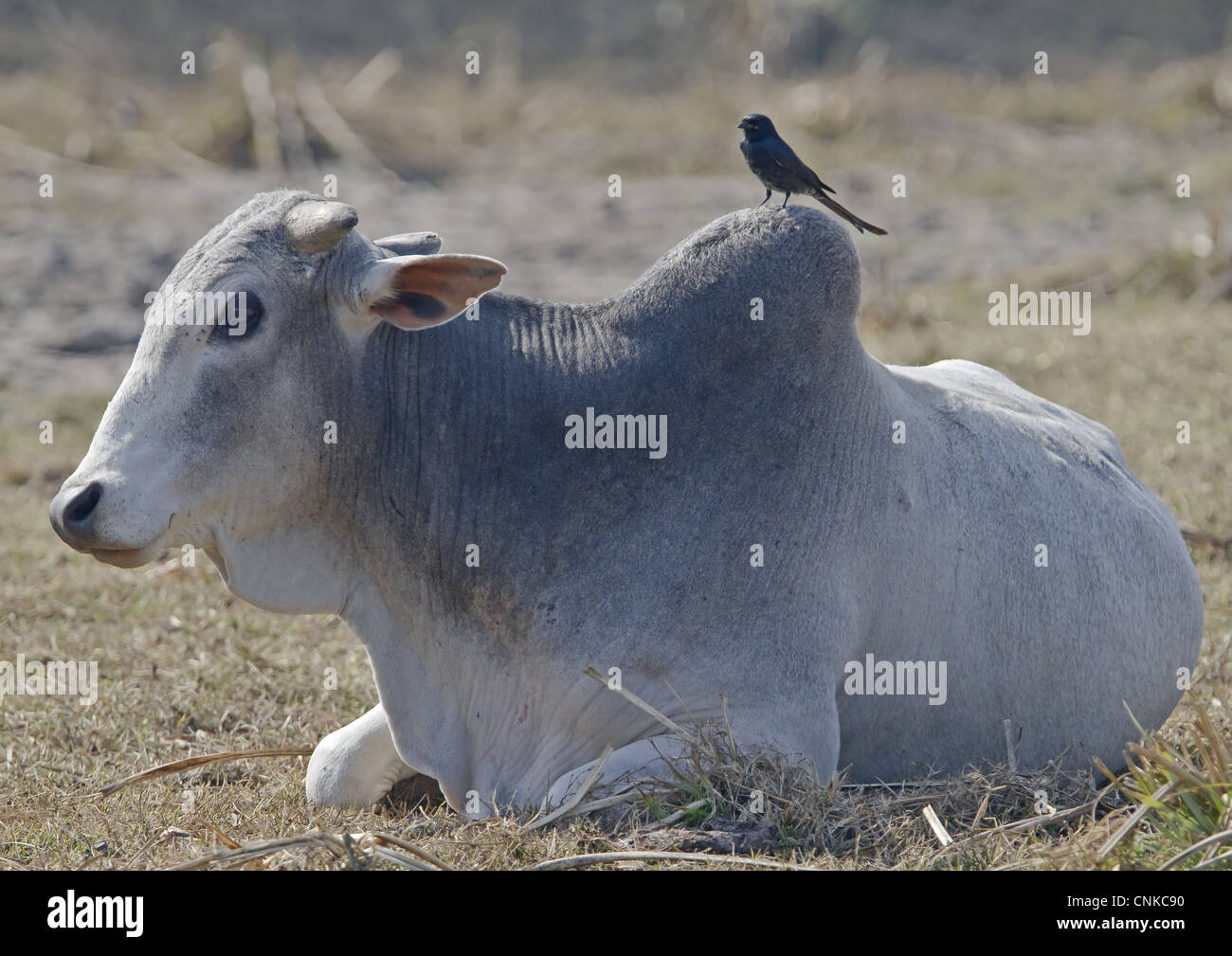 Modern photograph of black drongo perched on the hump of a zebu bovine.
Modern photograph of black drongo perched on the hump of a zebu bovine.










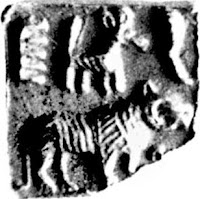

 Seal impression of m296
Seal impression of m296




